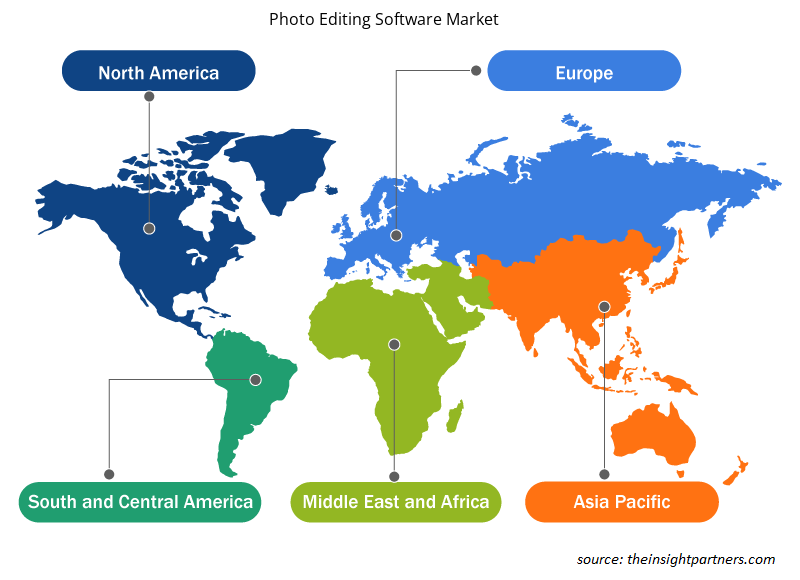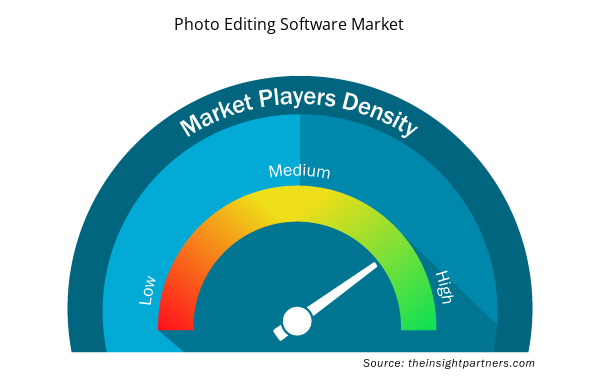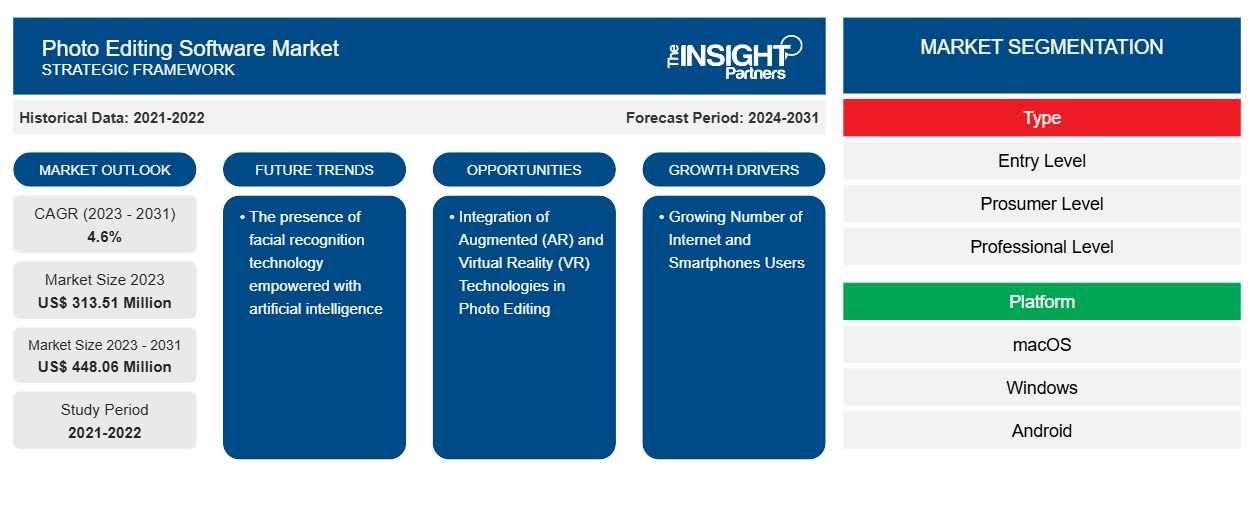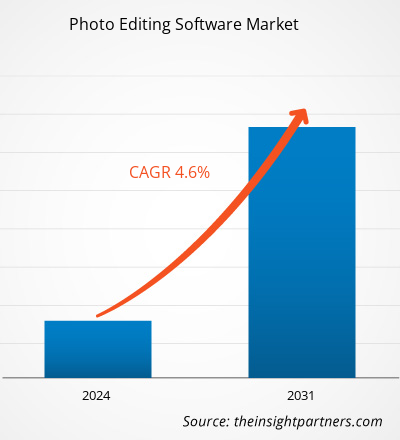Der Markt für Bildbearbeitungssoftware soll von 313,51 Millionen US-Dollar im Jahr 2023 auf 448,06 Millionen US-Dollar im Jahr 2031 anwachsen. Der Markt soll zwischen 2023 und 2031 eine durchschnittliche jährliche Wachstumsrate (CAGR) von 4,6 % verzeichnen. Die Präsenz von Gesichtserkennungstechnologie mit künstlicher Intelligenz dürfte ein wichtiger Trend auf dem Markt für Bildbearbeitungssoftware bleiben.
Marktanalyse für Bildbearbeitungssoftware
Der Markt für Bildbearbeitungssoftware wächst aufgrund der steigenden Zahl von Internet- und Smartphone-Nutzern und der steigenden Nachfrage der Verbraucher nach digitalen Fotos rasant. Der Markt wächst stetig, angetrieben durch den steigenden Bedarf an hochauflösenden Qualitätsbildern für private und kommerzielle Zwecke. Darüber hinaus bieten die Integration von Augmented-Reality-Technologien (AR) und Virtual Reality-Technologien (VR) in die Bildbearbeitung und die zunehmende Verwendung von Computeralgorithmen in Bildbearbeitungssoftware lukrative Möglichkeiten für Marktwachstum.
Marktübersicht für Bildbearbeitungssoftware
Fotobearbeitungssoftware ist eine digitale Fotoanwendung, mit der Benutzer ihre Fotos nach Bedarf zuschneiden, reparieren und organisieren können. Die Software kann gescannte Fotos von alten Filmfotografien nehmen und sie in digitale Bilder umwandeln. Diese Bilder werden weiter digital restauriert, indem Defekte entfernt und die Bildqualität verbessert werden. Die Nachfrage nach Spezialeffekten in Fotos, darunter Farbe, Farbtöne, Bildausrichtung, digitale Fotos und Ebenenbearbeitung, treibt den Markt während des gesamten Prognosezeitraums an.
Passen Sie diesen Bericht Ihren Anforderungen an
Sie erhalten kostenlose Anpassungen an jedem Bericht, einschließlich Teilen dieses Berichts oder einer Analyse auf Länderebene, eines Excel-Datenpakets sowie tolle Angebote und Rabatte für Start-ups und Universitäten.
- Holen Sie sich die wichtigsten Markttrends aus diesem Bericht.Dieses KOSTENLOSE Beispiel umfasst eine Datenanalyse von Markttrends bis hin zu Schätzungen und Prognosen.
Treiber und Chancen auf dem Markt für Bildbearbeitungssoftware
Wachsende Zahl von Internet- und Smartphone-Nutzern treibt den Markt an
Die wachsende Internetnutzung steigert die Nachfrage nach Smartphones bei Verbrauchern auf der ganzen Welt und treibt den Markt an. Das Internet und Smartphones sind zwei der Hauptfaktoren, die den Markt antreiben. Die wachsende Zahl von Smartphone-Nutzern ist mit dem Einfluss sozialer Medien verbunden, wodurch die Nachfrage nach Bildbearbeitungssoftware bei Verbrauchern steigt. Darüber hinaus ermutigt die steigende Beliebtheit von Smartphones Marktanbieter, Bildbearbeitungssoftware zu entwickeln, die speziell für Smartphones konzipiert ist. Smartphone-Hersteller integrieren Bildbearbeitungsfunktionen auch direkt in die primäre Kamera-App, sodass Benutzer Lichtabgleich und Belichtungseffekte ihrer Fotos in Echtzeit prüfen, ändern und verwalten können. Die zunehmende Kamerafähigkeit und Verarbeitungsleistung von Smartphones veranlassen Hersteller, überlegene mobile Bildbearbeitungsanwendungen zu entwickeln, und beflügeln so die Branche.
Integration von Augmented (AR) und Virtual Reality (VR) Technologien in die Fotobearbeitung – Eine Chance auf dem Markt für FotobearbeitungssoftwareVR) Technologies in Photo Editing – An Opportunity in the Photo Editing Software Market
Die Integration von Augmented-Reality- und Virtual-Reality-Technologien in die Fotobearbeitung ermöglicht es Benutzern, realistischere Effekte auf aufgenommene Bilder anzuwenden und sie dadurch ansprechender zu gestalten. Darüber hinaus sorgt die Verwendung von AR- und VR-Technologien für ein genaues und realistisches Bild des Bildes, indem sie dessen Qualität verbessern, was die Nachfrage bei den Verbrauchern erhöht und Chancen auf dem Markt schafft. Darüber hinaus ermöglicht die Verwendung von AR-Technologie in der Fotobearbeitung Endbenutzern, realistische Effekte hinzuzufügen und gleichzeitig ein genaues und realistisches Bild zu liefern. Darüber hinaus macht das Aufkommen erfolgreicherer Tiefensensoren in Smartphone-Kameras die Einbindung von Augmented Reality in den Fotobearbeitungsprozess einfach. Somit schafft die zunehmende Einbindung von AR- und VR -Technologien in Fotobearbeitungssoftware erhebliche Wachstumschancen für den Markt.VR technologies provides an exact and realistic picture of the image by enhancing its quality, which increases the demand among consumers and creates opportunities in the market. Moreover, using AR technology in photo editing allows end users to add realistic effects while providing an accurate and realistic image. Furthermore, the advent of more successful depth sensors in smartphone cameras makes it simple to incorporate augmented reality into the photo editing process. Thus, the increasing incorporation of VR
Marktbericht zur Bildbearbeitungssoftware – Segmentierungsanalyse
Wichtige Segmente, die zur Ableitung der Marktanalyse für Bildbearbeitungssoftware beigetragen haben, sind Typ, Plattform und Endbenutzer.
- Der Markt für Bildbearbeitungssoftware ist nach Typ in Einsteiger-, Prosumer- und Profi-Level unterteilt. Das Segment der Prosumer-Level hatte im Jahr 2023 einen größeren Marktanteil.
- Auf der Grundlage der Plattform ist der Markt für Fotobearbeitungssoftware in macOS, Windows, Android und iOS unterteilt. Das Windows-Segment hatte im Jahr 2023 einen größeren Marktanteil.
- In Bezug auf die Endnutzer wird der Markt in privat und gewerblich unterteilt. Das gewerbliche Segment hatte im Jahr 2023 einen größeren Marktanteil.
Marktanteilsanalyse für Bildbearbeitungssoftware nach geografischer Lage
Der geografische Umfang des Marktberichts für Bildbearbeitungssoftware ist hauptsächlich in fünf Regionen unterteilt: Nordamerika, Asien-Pazifik, Europa, Naher Osten und Afrika sowie Südamerika/Süd- und Mittelamerika.
In Bezug auf den Umsatz hatte Nordamerika den größten Marktanteil bei Bildbearbeitungssoftware. Die Einführung von Social-Media-Werbung, die Präsenz bekannter Modemarken, der Aufstieg des Online-Werbesektors, die Expansion der E-Commerce-Branche und das Wachstum kleiner und mittelständischer Unternehmen sind wichtige Faktoren, die zum Wachstum des regionalen Marktes beigetragen haben. Die hohe Verbreitung von Internet, modernen Computern und Smartphones in den USA und Kanada hat ein günstiges Klima für das Wachstum der Video-Streaming-Branche geschaffen, was den Markt in der Region voraussichtlich ankurbeln wird.
Regionale Einblicke in den Markt für Bildbearbeitungssoftware
Die regionalen Trends und Faktoren, die den Markt für Bildbearbeitungssoftware im Prognosezeitraum beeinflussen, wurden von den Analysten von Insight Partners ausführlich erläutert. In diesem Abschnitt werden auch die Marktsegmente und die Geografie von Bildbearbeitungssoftware in Nordamerika, Europa, im asiatisch-pazifischen Raum, im Nahen Osten und Afrika sowie in Süd- und Mittelamerika erörtert.

- Holen Sie sich die regionalen Daten für den Markt für Bildbearbeitungssoftware
Umfang des Marktberichts zur Bildbearbeitungssoftware
| Berichtsattribut | Details |
|---|---|
| Marktgröße im Jahr 2023 | 313,51 Millionen US-Dollar |
| Marktgröße bis 2031 | 448,06 Millionen US-Dollar |
| Globale CAGR (2023 - 2031) | 4,6 % |
| Historische Daten | 2021-2022 |
| Prognosezeitraum | 2024–2031 |
| Abgedeckte Segmente | Nach Typ
|
| Abgedeckte Regionen und Länder | Nordamerika
|
| Marktführer und wichtige Unternehmensprofile |
|
Dichte der Marktteilnehmer für Bildbearbeitungssoftware: Die Auswirkungen auf die Geschäftsdynamik verstehen
Der Markt für Bildbearbeitungssoftware wächst rasant, angetrieben durch die steigende Nachfrage der Endnutzer aufgrund von Faktoren wie sich entwickelnden Verbraucherpräferenzen, technologischen Fortschritten und einem größeren Bewusstsein für die Vorteile des Produkts. Mit steigender Nachfrage erweitern Unternehmen ihr Angebot, entwickeln Innovationen, um die Bedürfnisse der Verbraucher zu erfüllen, und nutzen neue Trends, was das Marktwachstum weiter ankurbelt.
Die Marktteilnehmerdichte bezieht sich auf die Verteilung der Firmen oder Unternehmen, die in einem bestimmten Markt oder einer bestimmten Branche tätig sind. Sie gibt an, wie viele Wettbewerber (Marktteilnehmer) in einem bestimmten Marktraum im Verhältnis zu seiner Größe oder seinem gesamten Marktwert präsent sind.
Die wichtigsten Unternehmen auf dem Markt für Bildbearbeitungssoftware sind:
- ACD Systems International Inc.
- Adobe
- CyberLink Corp
- Kernunternehmen
- DXO
- INMAGINE-GRUPPE
Haftungsausschluss : Die oben aufgeführten Unternehmen sind nicht in einer bestimmten Reihenfolge aufgeführt.

- Überblick über die wichtigsten Akteure auf dem Markt für Bildbearbeitungssoftware
Neuigkeiten und aktuelle Entwicklungen zum Markt für Bildbearbeitungssoftware
Der Markt für Bildbearbeitungssoftware wird durch die Erhebung qualitativer und quantitativer Daten nach Primär- und Sekundärforschung bewertet, die wichtige Unternehmensveröffentlichungen, Verbandsdaten und Datenbanken umfasst. Im Folgenden finden Sie eine Liste der Entwicklungen auf dem Markt für Bildbearbeitungssoftware und -strategien:
- Im Februar 2024 kündigt DxO Software-Support für Canons spannendes kompaktes 10-18-mm-RF-S-Objektiv und mehr an. Die Bibliothek der DxO Optics Module umfasst jetzt Profi-Ausrüstung von Leica und Hasselblad sowie neue Objektive für Benutzer von Nikon, Sony, Fuji und L-Mount. Diese DxO Optics Module und mehr sind in den neuesten Versionen aller DxO-Fotobearbeitungssoftwareprodukte enthalten. (Quelle: DxO, Pressemitteilung, 2024)
Marktbericht zu Bildbearbeitungssoftware – Umfang und Ergebnisse
Der Bericht „Marktgröße und Prognose für Fotobearbeitungssoftware (2021–2031)“ bietet eine detaillierte Analyse des Marktes, die die folgenden Bereiche abdeckt:
- Marktgröße und Prognose auf globaler, regionaler und Länderebene für alle wichtigen Marktsegmente, die im Rahmen des Projekts abgedeckt sind
- Marktdynamik wie Treiber, Beschränkungen und wichtige Chancen
- Wichtige Zukunftstrends
- Detaillierte PEST/Porters Five Forces- und SWOT-Analyse
- Globale und regionale Marktanalyse mit wichtigen Markttrends, wichtigen Akteuren, Vorschriften und aktuellen Marktentwicklungen
- Branchenlandschaft und Wettbewerbsanalyse, einschließlich Marktkonzentration, Heatmap-Analyse, prominenten Akteuren und aktuellen Entwicklungen
- Detaillierte Firmenprofile
- Historische Analyse (2 Jahre), Basisjahr, Prognose (7 Jahre) mit CAGR
- PEST- und SWOT-Analyse
- Marktgröße Wert/Volumen – Global, Regional, Land
- Branche und Wettbewerbsumfeld
- Excel-Datensatz


- Electronic Health Record Market
- Adaptive Traffic Control System Market
- Skin Tightening Market
- Electronic Data Interchange Market
- UV Curing System Market
- Identity Verification Market
- Fill Finish Manufacturing Market
- Electronic Toll Collection System Market
- Mobile Phone Insurance Market
- Tortilla Market

Report Coverage
Revenue forecast, Company Analysis, Industry landscape, Growth factors, and Trends

Segment Covered
This text is related
to segments covered.

Regional Scope
North America, Europe, Asia Pacific, Middle East & Africa, South & Central America

Country Scope
This text is related
to country scope.
Häufig gestellte Fragen
The global photo editing software market was estimated to be US$ 313.51 million in 2023 and is expected to grow at a CAGR of 4.6% during the forecast period 2023 - 2031.
The growing number of internet and smartphone users and the growing demand for digital photographs among consumers are the major factors that propel the global photo editing software market.
The presence of facial recognition technology empowered with artificial intelligence to play a significant role in the global photo editing software market in the coming years.
The key players holding majority shares in the global photo editing software market are ACD Systems International Inc., Adobe, CyberLink Corp, Core Corporation, and DXO.
The global photo editing software market is expected to reach US$ 448.06 million by 2031.
The incremental growth expected to be recorded for the global photo editing software market during the forecast period is US$ 134.54 million.
Trends and growth analysis reports related to Technology, Media and Telecommunications : READ MORE..
The Insight Partners performs research in 4 major stages: Data Collection & Secondary Research, Primary Research, Data Analysis and Data Triangulation & Final Review.
- Data Collection and Secondary Research:
As a market research and consulting firm operating from a decade, we have published and advised several client across the globe. First step for any study will start with an assessment of currently available data and insights from existing reports. Further, historical and current market information is collected from Investor Presentations, Annual Reports, SEC Filings, etc., and other information related to company’s performance and market positioning are gathered from Paid Databases (Factiva, Hoovers, and Reuters) and various other publications available in public domain.
Several associations trade associates, technical forums, institutes, societies and organization are accessed to gain technical as well as market related insights through their publications such as research papers, blogs and press releases related to the studies are referred to get cues about the market. Further, white papers, journals, magazines, and other news articles published in last 3 years are scrutinized and analyzed to understand the current market trends.
- Primary Research:
The primarily interview analysis comprise of data obtained from industry participants interview and answers to survey questions gathered by in-house primary team.
For primary research, interviews are conducted with industry experts/CEOs/Marketing Managers/VPs/Subject Matter Experts from both demand and supply side to get a 360-degree view of the market. The primary team conducts several interviews based on the complexity of the markets to understand the various market trends and dynamics which makes research more credible and precise.
A typical research interview fulfils the following functions:
- Provides first-hand information on the market size, market trends, growth trends, competitive landscape, and outlook
- Validates and strengthens in-house secondary research findings
- Develops the analysis team’s expertise and market understanding
Primary research involves email interactions and telephone interviews for each market, category, segment, and sub-segment across geographies. The participants who typically take part in such a process include, but are not limited to:
- Industry participants: VPs, business development managers, market intelligence managers and national sales managers
- Outside experts: Valuation experts, research analysts and key opinion leaders specializing in the electronics and semiconductor industry.
Below is the breakup of our primary respondents by company, designation, and region:

Once we receive the confirmation from primary research sources or primary respondents, we finalize the base year market estimation and forecast the data as per the macroeconomic and microeconomic factors assessed during data collection.
- Data Analysis:
Once data is validated through both secondary as well as primary respondents, we finalize the market estimations by hypothesis formulation and factor analysis at regional and country level.
- Macro-Economic Factor Analysis:
We analyse macroeconomic indicators such the gross domestic product (GDP), increase in the demand for goods and services across industries, technological advancement, regional economic growth, governmental policies, the influence of COVID-19, PEST analysis, and other aspects. This analysis aids in setting benchmarks for various nations/regions and approximating market splits. Additionally, the general trend of the aforementioned components aid in determining the market's development possibilities.
- Country Level Data:
Various factors that are especially aligned to the country are taken into account to determine the market size for a certain area and country, including the presence of vendors, such as headquarters and offices, the country's GDP, demand patterns, and industry growth. To comprehend the market dynamics for the nation, a number of growth variables, inhibitors, application areas, and current market trends are researched. The aforementioned elements aid in determining the country's overall market's growth potential.
- Company Profile:
The “Table of Contents” is formulated by listing and analyzing more than 25 - 30 companies operating in the market ecosystem across geographies. However, we profile only 10 companies as a standard practice in our syndicate reports. These 10 companies comprise leading, emerging, and regional players. Nonetheless, our analysis is not restricted to the 10 listed companies, we also analyze other companies present in the market to develop a holistic view and understand the prevailing trends. The “Company Profiles” section in the report covers key facts, business description, products & services, financial information, SWOT analysis, and key developments. The financial information presented is extracted from the annual reports and official documents of the publicly listed companies. Upon collecting the information for the sections of respective companies, we verify them via various primary sources and then compile the data in respective company profiles. The company level information helps us in deriving the base number as well as in forecasting the market size.
- Developing Base Number:
Aggregation of sales statistics (2020-2022) and macro-economic factor, and other secondary and primary research insights are utilized to arrive at base number and related market shares for 2022. The data gaps are identified in this step and relevant market data is analyzed, collected from paid primary interviews or databases. On finalizing the base year market size, forecasts are developed on the basis of macro-economic, industry and market growth factors and company level analysis.
- Data Triangulation and Final Review:
The market findings and base year market size calculations are validated from supply as well as demand side. Demand side validations are based on macro-economic factor analysis and benchmarks for respective regions and countries. In case of supply side validations, revenues of major companies are estimated (in case not available) based on industry benchmark, approximate number of employees, product portfolio, and primary interviews revenues are gathered. Further revenue from target product/service segment is assessed to avoid overshooting of market statistics. In case of heavy deviations between supply and demand side values, all thes steps are repeated to achieve synchronization.
We follow an iterative model, wherein we share our research findings with Subject Matter Experts (SME’s) and Key Opinion Leaders (KOLs) until consensus view of the market is not formulated – this model negates any drastic deviation in the opinions of experts. Only validated and universally acceptable research findings are quoted in our reports.
We have important check points that we use to validate our research findings – which we call – data triangulation, where we validate the information, we generate from secondary sources with primary interviews and then we re-validate with our internal data bases and Subject matter experts. This comprehensive model enables us to deliver high quality, reliable data in shortest possible time.


 Holen Sie sich ein kostenloses Muster für diesen Bericht
Holen Sie sich ein kostenloses Muster für diesen Bericht